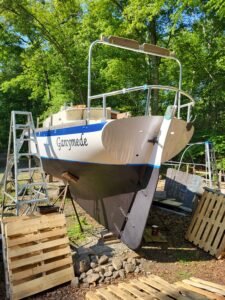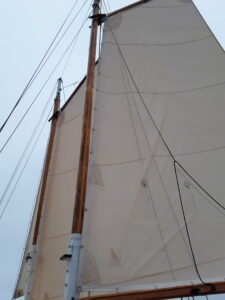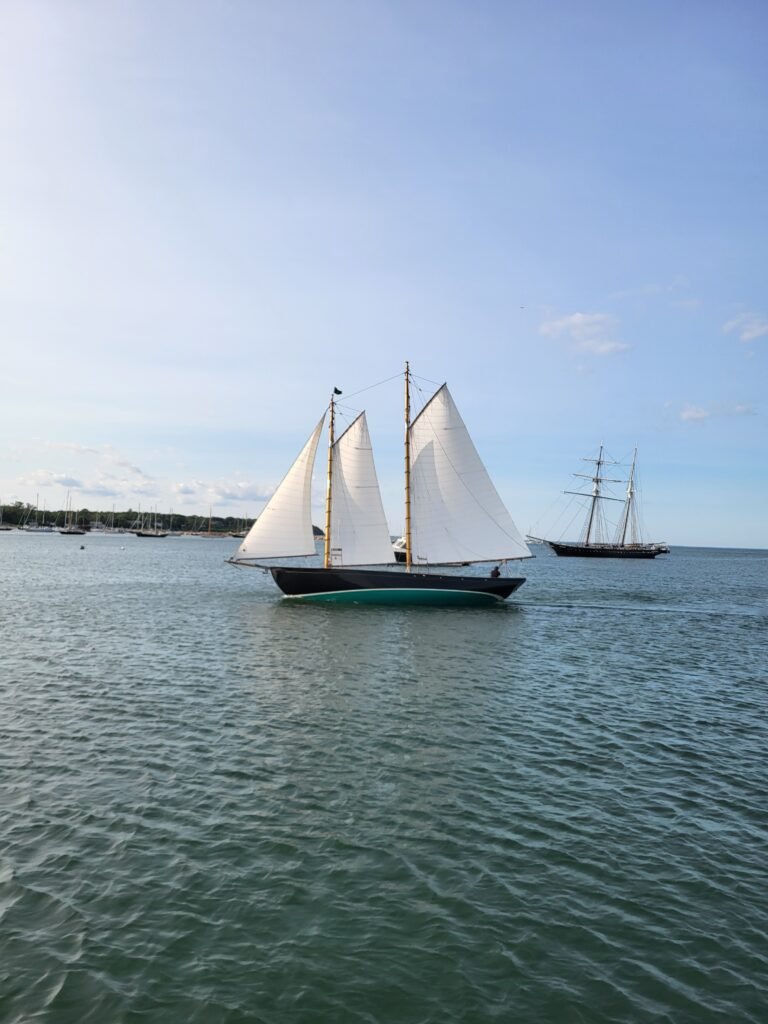
In deciding whether to put a modern gaff rig on a new build, or change the rig of an older boat to a gaff, several things must be considered. The first is the hull. A properly designed rig is not an afterthought on a hull: it’s part of the overall design, and the two must complement each other. Racers with bulbed fin keels and spade rudders are optimized for super-tight, high-aspect ratio sail plans, where every molecule is strained to the limit to get the last scrap of windward performance out of it. To put a slack, easy, comfortable gaff rig on this type of hull would be to rob it of the few degrees of weatherliness they’ve sacrificed so much for, since the sails would stall before the hull did. But by the same token, to put a high-aspect ratio Marconi sail that could point higher to weather on a hull that’s happier when cracked off a few degrees makes very little sense. The required rig height and tension of the Marconi, the complication and bother of travelers, and winches, and other expensive tackle, and the additional wear and tear on gear strained nearer its limit further diminishes the appeal.
Why then did the Marconi rig with its funny jib-headed mainsail become so popular on cruising boats, the gaff-doubtful will ask? Well, it happened because clever marketers wanted to sell something new and expensive: the racer-cruiser, which is supposed to be the best of both worlds. Fast as a raceboat, comfortable as a cruiser. By the time people realized that all they did was combine the worst of both with the advantages of neither, the trend had been set, the money spent, the designers in a rut, and hulls with overhangs, cutaways, and skeg-hung or worse: spade rudders, had flooded the market, and a gaff rig is largely wasted on these. That’s not to say that some of these designs wouldn’t benefit from being retrofitted with a gaff rig, but it might prove a strained and difficult marriage.

However, let bygones be bygones, and let’s return to the beautiful union of cruising hull with cruising rig. Any decently beamy, heavy hull, with a keel at least mostly full, slack bilges, and an attached rudder—in short, a hull designed with comfortable, dry passagemaking in mind will be the perfect platform for a gaff rig. The advantages of a such a rig are immediate and obvious, but let’s begin with the engineering side.
Because a gaff-headed sail is trapezoidal, it requires less luff length for a given sail area than a triangle. That means that the mast can be shorter, and therefore:
- Is easier to stay.
- Reduces weight aloft with all its associated evils.
- Can carry more sail in higher winds with less heel.
- Heaves-to better, with the Center of Effort staying aft as reefs are put in.
- Is more handily managed when stepping/unstepping/transporting.
- Is more simple to design and build
Let’s flesh these out a little with some real-world data. The standard Cape George 31’s designed Marconi mast length is twelve feet taller than Ganymede’s, and still carries twenty square feet less of mainsail: 280 compared to Ganymede’s 300. But that taller mast requires far more highly tensioned shrouds to carry less sail, and just the spar section, without fittings and wires, puts sixty extra pounds up there! Add to that the mind-numbing price of a suitable extrusion—you can’t just use any old pole—and the DIY builder, who’s ingenuity must be in proportion to his poverty, begins to see that paying several thousand extra dollars to have several hundred pounds more of metal twelve feet further up, all to show less canvas, is like robbing Peter to stab Paul.

Ganymede’s mast and rigging, all told: spars, fittings, shrouds, and hardware, came in at just under $3,000 in 2009. A Marconi setup would have called the tune of $10,000. Sure, I did most of the work myself, but a Marconi rig would have required a good deal of work too, and I’d never have been able to step it in a tabernacle to raise and lower at will—but I’m getting ahead of myself.
We’ll talk all about shroud angles and scantlings later on, but let’s discuss some more of the general advantages of that setup for now. With mast hoops rather than track slugs to jam or expensive batten cars that take up lots of space, the mainsail is far easier to hoist and strike than a jib-headed one, and can be reefed on any point of sail with little difficulty. Having both throat and peak halyards, there is no need for halyard winches—an 80-foot steel schooner that I was once captain of did five full-sail trips a day with a captain and two crew, and not a single winch aboard. There’s technique involved, but we’ll get to that later on as well.
One of the great things about a gaff-headed mainsail is that it is the primary driver of the boat, so the headsails can be smaller and more easily handled, and sailing dead downwind with the main alone is a joy. Because the gaff twists off to leeward so far when sailing large, you can safely sail by the lee with little danger of a crash gybe. Should a gybe occur, the several passes of peak halyard serve to absorb the shock so it’s neither taken up entirely by the leech of the sail nor violently transferred to the boom hardware. Still, in all her miles of sailing by the lee Ganymede’s only been crash-gybed once, and though unpleasant, nothing broke or was endangered.

This feature of being able to maneuver the boat with mainsail alone makes Ganymede very easy to sail in and out of narrow channels, and on and off her mooring without resorting to the motor. When in close quarters, the sail is easily de-powered, “scandalizing” the gaff by easing the peak halyard, so that way can be taken off when sailing up to a jetty or mooring, and quickly regained by snugging the halyard up again. It’s like tapping the brakes when there’s no more sheet to let out. Having the main hoisted but scandalized when getting the anchor up under sail keeps the boat from horsing around, but ready at a moment’s notice to “peak up” and get underway.
When sailing in big seas, forward momentum is key to a stable ride: like a bicycle that wants to stay upright as long as it has forward motion, but will tip over when that’s gone, a boat moving forward will wallow less, and the faster it goes, the less it wallows. With her ability to carry more sail lower down, the gaffer can maintain more speed in rough weather without a huge lever arm up high pushing her rail under.
And if you’re not convinced yet of the clear advantages of a gaff rig, picture yourself approaching a coral-strewn pass in the tropics, and scrambling casually up the mast hoops to stand with one foot on the gaff and the other on a spreader to call directions down to the deck. Tying on a hasty sarong for the benefit of the gaping natives, your lady love takes both tiller and sheet in one hand and easily steers wherever you signal. The shadow of the sail in the westering sun passes across the thatch of the huts on shore, and dang, it looks good.

